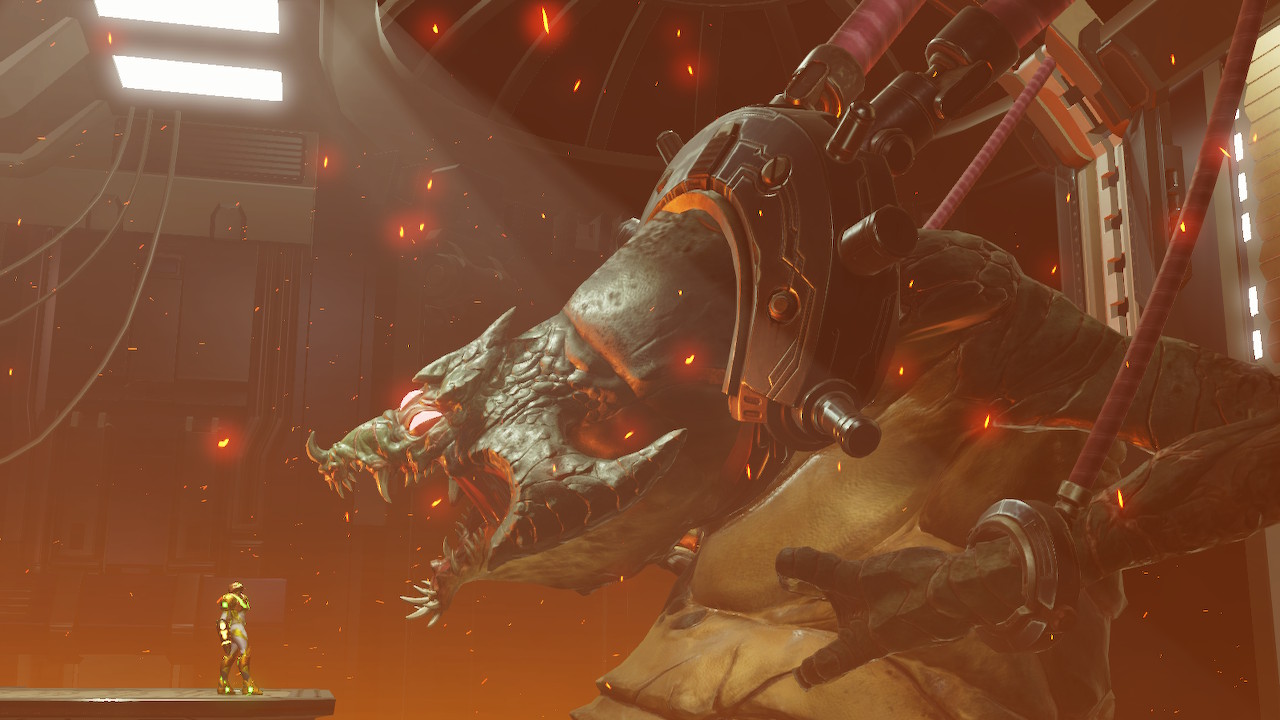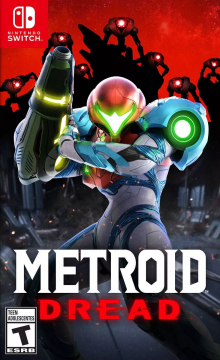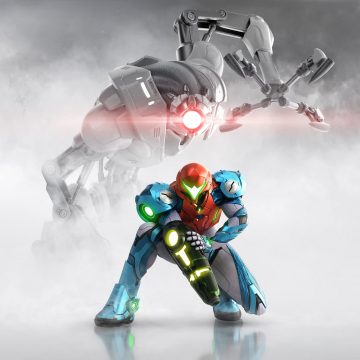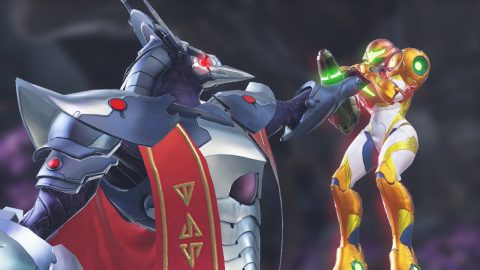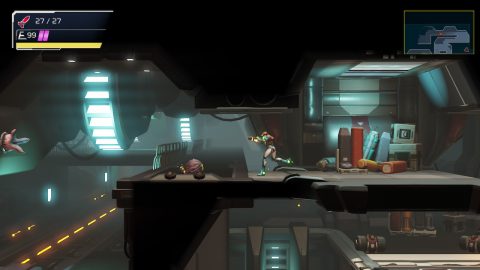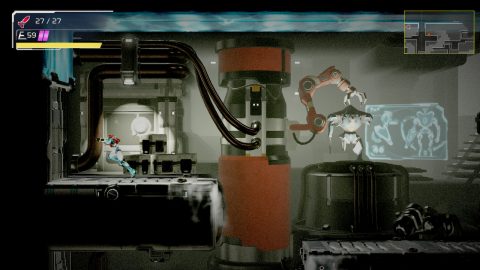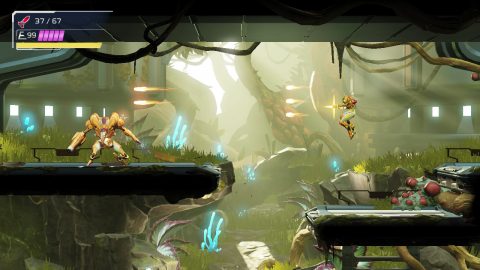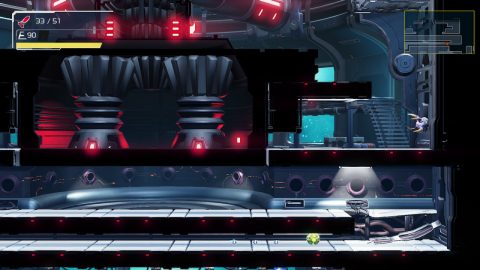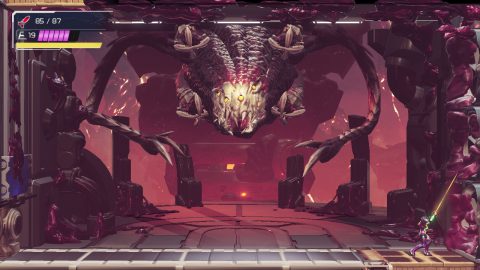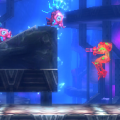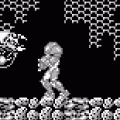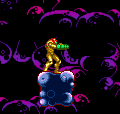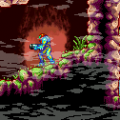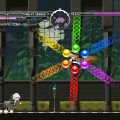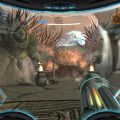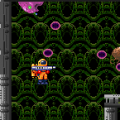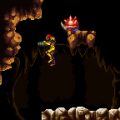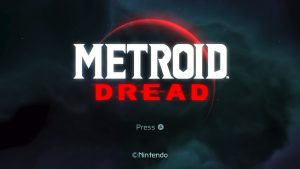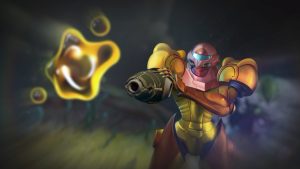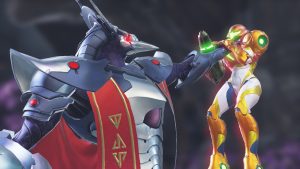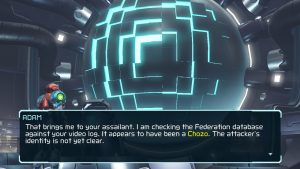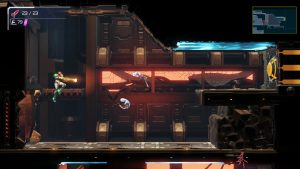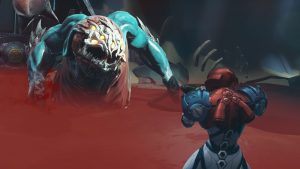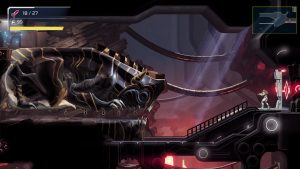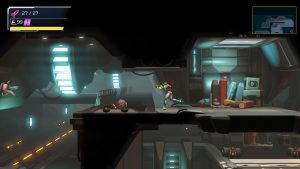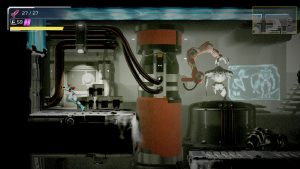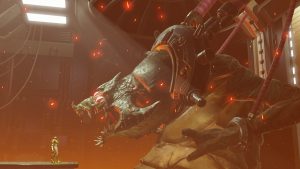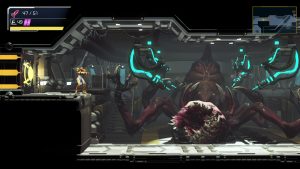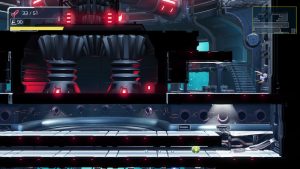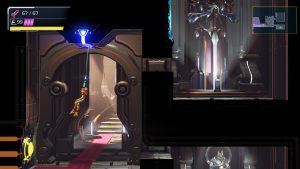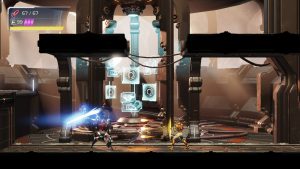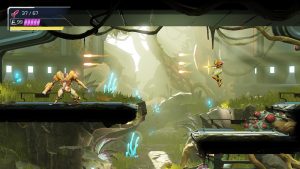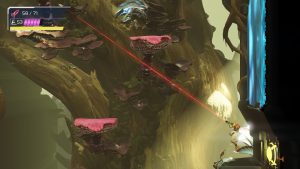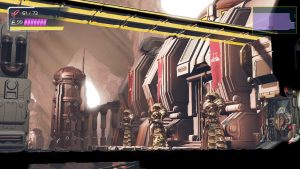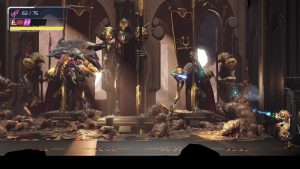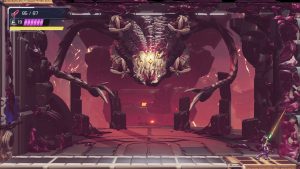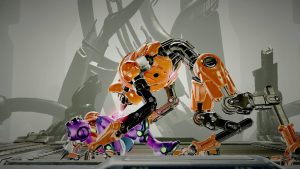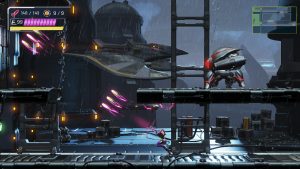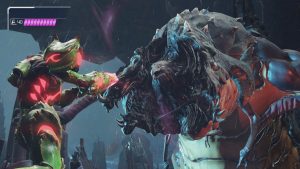For most of the 2010’s, the Metroid franchise was in a bad spot. Metroid: Other M had flopped, Metroid Prime 4 was nowhere to be seen, and Federation Force was hardly a consolation. 2017’s Samus Returns wasn’t mind-blowing, but it still brought some life back to the series and showed off what developer MercurySteam was capable of. Nintendo must’ve agreed, because they put them in charge of Metroid Dread, released in 2021 for the Switch, the first game in the core Metroid series since 2002’s Metroid Fusion.
Metroid Dread had been kicking around as a concept for awhile. It was initially announced as a DS game for release in 2006, and then dropped off the calendar with little explanation. It was revised internally in 2008, with a prototype created that has yet to be shown publicly, but this too was canceled. Producer Yoshio Sakamoto indicated that the DS wasn’t powerful enough for the game he wanted to create. One of the mission logs in Metroid Prime 3 made reference to a “Metroid project Dread” that ended up getting canned, though this was placed as a joke rather than an actual inter-game reference.
The story here is a direct sequel to Fusion, as Samus is sent to planet ZDR to investigate the spread of the X parasite. When she lands, she is immediately accosted by a Chozo warrior named Raven Beak and knocked out, awakening deep within the planet. Communicating with her ship, her only mission now is to reach the surface and escape, but not before building her strength and facing off against the figure that captured her in the first place. She also had to deal with robots that were dispatched for an exploratory mission and never came back; called EMMI (Extraplanetary Multiform Mobile Identifiers), these terrifying mechanical beings have been reprogrammed to stalk and capture Samus, who cannot defeat them directly.
Since Metroid Dread is developed by the same folks as Samus Returns, the controls and general feel are similar, though substantially improved. Samus now moves at an incredible speed, being able to cover a large amount of ground very quickly. Movement is still restricted to the analog pad, as with Samus Returns, since you can aim your weapon at any angle. However, everything is much smoother in Metroid Dread thanks to the Switch hardware and a 60 FPS framerate, as well as the larger resolution that allows for a more zoomed-out camera. The counter-attack is more fluid than before, though this entry doesn’t rely on it quite as much, plus a new melee attack executed when running. Making Samus feel like a super agile, badass action hero has been the Metroid series’ goal reaching back to Metroid Fusion, and with the evolution continuing through Other M and up to Metroid Dread, it’s never felt better.
The “dread” of the title seemingly alludes to the EMMI robots, as a way to constantly put Samus in danger. There are seven of them throughout the game, though their presence is restricted to certain zones on the map, which are presented with a chilly, monochromatic color scheme and film grain effects. The SA-X encounters from Fusion were the high points of the game, but there weren’t very many of them, and they were all scripted. The EMMI skirmishes build off of this, but not only are they more prevalent but much more harrowing, due to the AI that commands them to ruthlessly hunt down Samus. Normal weapons are useless against them, so the only thing to do, at first, is to try to avoid them.
These aren’t quite stealth segments like the kind seen at the end of Zero Mission – instead, they’re more like games of tag, as you try to avoid detection from the EMMI, and then run like hell if you do. The EMMI hunts by sound so it will always have a vague idea of where you are if you’re moving, though if it actually detects you with its scanner, it will more quickly and aggressively home in on your position. When its on high alert, the doors to the zone shut down, and the only thing to do is evade it until it calms down. If it collides with Samus, there’s an extremely short window of time where you can employ a counterattack and stun it, allowing you to escape, but this is so tough to hit regularly that if you’re caught, you may as well just assume that you’re dead.
In terms of layout, each EMMI zone has a central core. In a reference to the original Metroid, these look like small Mother Brains, complete with similar defenses systems that shoot out lasers and little ring beams. They’re fairly simple to take down and even activate your Omega Beam powers, allowing you to destroy an EMMI. You can’t just run up and shoot it, though – you need to find an appropriate spot that places enough distance between Samus and the robot, then hammer its head for a few seconds with a rapid-fire laser. When aiming this weapon, the viewpoint switches to an over-the-shoulder camera, allowing you to more easily target its weakpoint. With its shield down, you can then charge up a more powerful laser and take aim at its head for the final killing blow. This will usually grant you a new power, as well as letting you navigate the EMMI zone without running into trouble.
From a design standpoint, these encounters are tricky to get right – if they’re too prevalent or difficult, then they become tedious, but if they’re not challenging enough, they become inconsequential. For the most part, Metroid Dread balances this well – though the EMMI rarely invoke fear in the same way the SA-X did, they can still make for some incredibly intense standoffs.
However, until you get used to it, you will almost definitely die a lot in Metroid Dread, far more than previous titles. Boss battles, too, are significantly more challenging, since the damage output is extremely high. But they all have readable patterns, as well as certain moves that can be countered that not only inflict a lot of damage, but also restore your health and missiles. Dying sends you back to a checkpoint rather than a save station – right before the EMMI zones or the boss encounters, case-depending – so even when you do die, it’s just a few seconds before you can get back out there and try again.
The boss battles themselves are also some of the best the series has ever seen. Kraid returns for the first time since Super Metroid, where he’s just as enormous as he was there, but now even more of a threat. Other baddies include an underwater fight against the tentacled Drogyga and the electricity- conducting insect, Escue, as well as the particularly vicious monster Experiment No. Z-57 in the depths of the planet’s core. There are also several miniboss encounters with Chozo warriors, and while they play out similarly, they also get more tricks as you proceed through the game. They’re not nearly as pervasive as the Metroid encounters from Samus Returns, though near the end of the game, they do become a little tiresome.
Most of the standard Metroid power-ups return, though the Spider Ball is ditched here in favor of the Spider Magnet, which just lets Samus climb and hang on blue surfaces. Unusually, while you normally get the Morph Ball pretty early on in Metroid games, it takes a while before you find it in this entry, instead forcing Samus to rely on a slide maneuver to squeeze through tight spaces. The Aeion gauge from Samus Returns appears here as well and is required for a few of the powers, though it regenerates fairly quickly. Your loadout also includes the Phantom Cloak, which temporarily turns you invisible. This is handy for hiding during EMMI encounters, though only when it’s trying to sniff you out – if it’s on alert, it’ll still find your location and can also pin you down even if you’re cloaked. The Flash Shift lets you quickly dash forward or backward, which is quite a useful combat maneuver. The Storm Missile further expands your arsenal and lets you lock onto several targets (or even a single one) to send out a barrage of explosives, and the Cross Bomb has large, cross-shaped explosions that propel you farther forwards or upwards. These new powers are fun, though using them requires both rows of shoulder buttons, which is a bit of a pain on the Switch Joy Cons.
The development team seems to have been keenly aware of the feedback toward how previous games toned back the open-ended exploration in favor of linearity. Metroid Dread seems to have thankfully found a solid middle ground between these two design philosophies. Adam, your ship’s computer (not to be confused with Adam, Samus’ commanding officer from Other M, even though one was named after the other) will converse with you in certain rooms, summing up the story as well as your powers, as well as general instructions on your next goal. There aren’t any of the internal monologues of Fusion though and Samus only speaks very briefly, so outside of some brief story segments with other characters, the game retains the sense of loneliness missing from most recent Metroid games.
Further changes include the game no longer pinpointing progression goals on the map – there isn’t even a hint function a la Prime. Instead, the map itself has been modeled in far deeper detail than has ever been seen before in the 2D games, detailing the precise shape and size of every room rather than just presenting them as rectangular boxes. Not only that, it also keeps track of every type of destructible block you come across – bomb, missile, speed boosters, etc. – as well as every type of door, and even power-ups that you’ve collected, or have seen but haven’t been able to obtain. If you don’t have the necessary weapon to destroy a certain block or open a door, it’ll be marked as “???”, letting you know that you can’t access that area just yet. Additionally, rooms that contain a hidden item will be highlighted on the map with blinking lights, which is just helpful enough to lead you in the right direction without forcing you to shoot every block or scan constantly.
Other Metroid games (and Metroidvanias in general) make the player either rely on their memory or make them manually mark their maps for points of interest. Dread makes it much more user-friendly, giving you pretty much all of the information you need to proceed. This makes it feel like you’re figuring things out for yourself, instead of the game doing the work for you. Despite seeming to be open-ended, progression is actually pretty linear (outside of sequence breaks), as previous areas are often closed off to prevent yourself from wandering too far in the wrong direction. The critical path also sends you bouncing back and forth between zones, so it never feels like you’re just beating one level and moving on to the next. The downside to this is that you’re not always given the option to backtrack to look for extra missiles or energy tanks, which would’ve been pretty useful for some of the more difficult boss encounters.
Planet ZDR is broken up into nine areas in total, with mostly familiar territory for the series: the rocky Artaria, the lava-filled Cataris, the research site Dairon, the water-based Burenia, the Chozo sanctuaries Ferenia and Elun, the jungle Ghavoran, the military facility (and surface area) Hanubia, and the sky temple Itorash. There are transport elevators and shuttles between these areas, as well as color-coded teleporters to quickly move you to specific zones. These are paired off for most of the game so you can only jump between those specific points, though by the end of the game you can zoom off to wherever you wish. This is also pretty helpful since the map zigs and zags back and forth, with plenty of one-way areas, so making the rounds to find all of the extra hidden power-ups can be a little rough.
Regarding the presentation, the visuals are nice and clean, with plenty of subtle lighting effects adding to the atmosphere. This obviously isn’t a triple-A game as far as budget goes, but it looks decent enough, with some excellent cutscenes and nice animations. One issue is that the color scheme throughout the whole game is a little muted, and just doesn’t stand out in the same way as the 2D games, particularly Fusion, which had a pretty bright palette. It doesn’t help either that the EMMI zones look identical, regardless of what area you’re in.
The music, similarly, is a little same-y. The dramatic theme of Artaria recalls one of the main tracks in Metroid Fusion. Likewise, the Cataris tune is reminiscent of the Norfair track without reusing it directly (like so many other Metroid games did), but most of the rest are content just to blend into the background. A few remixes are spread throughout, like the Lower Brinstar theme from Super Metroid used in a cutscene. It’s a fantastic arrangement, but it highlights how unmemorable the rest of the music is. The soundtrack was provided by Nintendo of Japan and composed primarily by Soshi Abe and Sayako Doi, two newcomers who had collectively worked on games like The Legend of Zelda: Breath of the Wild and Pikmin 3.
The story itself is minimal, but serves as a fantastic continuation for the mainline series – since this is the sequel to Fusion, it’s basically “Metroid 5”. The Chozo have been around since the early days of the series – since they began as item-giving statues in the NES game, and the storyline has expanded them into a technologically advanced race that helped Samus. We’ve seen them in flashbacks, encountered their ruins, and read their lore, but we’ve never seen them directly outside of the Chozo ghost battles in the Metroid Prime games. Metroid Dread brings them to the forefront, making them the central figures of the game. This story is said to be the end of the main Metroid plot, and it’s interesting to see how each individual game contributes its own unique element to the story. The first one introduces Samus, the Space Pirates, and the Metroids (and Zero Mission expanded the Chozo lore stuff); the second showed us the Metroid homeworld, the third explained how Samus bonded with the baby Metroid, the fourth saw the debut of the SA-X, and the fifth brings everything together.
Metroid Dread is a brilliant game – even with all of competing Metroidvanias from indie developers, themselves inspired by the older games, it still finds its own place thanks to its story, world design, atmosphere, and incredible movement and combat mechanics. MercurySteam really pulled out every stop to ensure this is not only the best title they’ve done, but one of the best in the whole series.
